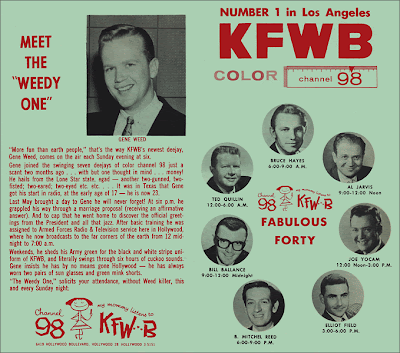Upon my official arrival, the guard at the gate was expecting me. No more guards posted to keep me in. The KHJ AM & TV parking lot had few spaces, all reserved for executives. Spotting the space with "Ron Jacobs" freshly painted on it, my emotions soared. I experienced the first of a series of mental orgasms that I would enjoy during the next four and a half years.
The three-story fortress contained the profit-making, high-profile KHJ-TV Channel 9, always in contention as L.A.’s top independent television station. In 1965, TV meant just about everything. The radio station had gone through a succession of vapid formats, none of which caught on. The radio-side was not a “profit center.” RKO General owned both stations, TV and radio. The radio station was AM. (This may seem superfluous, but KHJ-FM, to which none of our group paid any attention, broadcast from the KHJ-AM transmitter building at Fairfax Avenue and the Santa Monica Freeway. Later it would be renovated to also house FM studios, to be known as KRTH.)
In 1965, L.A. radio was different than the radio I knew from hustling trips to Hollywood in
1959 just so I could cruise Hollywood listening to KFWB Channel Ninety-EIGHT. B. Mitchell Reed influenced me more than any disc jockey I had ever heard. KFWB’s Program Director and my hero, Chuck Blore, was right up there with Babe Ruth, Elvis and John Wayne.
In Hawaii, the Pidgin English phrase for “goose pimples” is “chicken skin.” That was the reaction coming on in waves as I realized that this time, I had made it to Hollywood. All I had to do was perform and I would remain there. I was 27 years old. I had little doubt that I would succeed and be there for a while. It wasn’t necessarily arrogance, which both Morgan and I could switch on instantly to mask our insecurities. It was that the situation seemed so logical.
• KFWB. It was not the same station that first captivated the town with PD Blore’s great format and crew on January 1, 1958. We would be competing against a shadow of the real KFWB. Their energy had withered. Blore was gone. I figured that, with a sufficient budget, either Bill Drake or I, singularly, could out-program them.
• KRLA. Pasadena’s KRLA felt hotter than ’WB. At first glance, KFWB and KRLA’s combined ratings indicated that Top 40 radio was dead in the nation’s second largest market. But I knew the listeners were there, just as they were all over America. These stations needed a grenade going off in their backyard — figuratively speaking — to grab their attention and, heh heh, make them wonder what was coming next.
• Bill Drake. I had little in common with Drake other than our love of radio and the ambition to succeed. We respected one another as combatants in the savage 1963 ratings-war known in radio as “The Battle of Fresno.” I trusted Drake’s instincts. Sometimes it was frustrating when he pondered something endlessly, changed the subject or headed to Nickodell’s, the KHJ hangout next-door. There, Drake held court and tossed down “winky-poos.” Born in a place about as southern as it gets, Waycross, Georgia, Drake also dreamed of making it in Top 40 radio. Otherwise our only cultural connection was a mutual appreciation of boiled peanuts. We’d argue about whether the best of these slimy, oozing things came from Hawaii or Georgia.
• Survival Instincts. I was born in Hawaii but conceived somewhere between Long Island and New Jersey. People on the mainland meeting me for the first time assumed I was a fast-talking Jew from New York. Not so. I did inherit speed genes that came from a long line of people who had to think on their feet in order to survive. At work I was always one notch below full manic mode.
• Signal. If in real estate, it is “location, location, location,” when AM ruled the radio dial, the key was signal, signal, signal. KHJ’s coverage ranged over Southern California and to all the ships at sea. At 930 kilohertz, its bandwidth was broad enough to grab a car radio’s “scan” button.
• Autonomy. There would be no “orders from headquarters.” By 1965, the Drake-Chenault consultancy had done well at KGB, San Diego. That market had three stations chasing each other like mice in a treadmill. KCBQ or KDEO or KGB would be on top briefly, only to be supplanted by one of the others. Drake cleaned up KGB, further formulating the ideas he first put into effect at KYNO in Fresno in 1963. That was the same KYNO whose ass we at KMAK kicked until owner Gene
Chenault brought in Bill Drake to program it. Then the leverage switched from us to them. Chenault had just that one station. Its failure would have grave financial consequences, perhaps taking him out of the ownership arena. In contrast, I was with a group of three stations. In those days regulations limited a group to control of seven AM licenses.
How things change. The Telcom Act of 1996 changed the rules of the radio game. Relaxation of prior license limits now allows mega-corporations to buy and sell stations by the hundreds. The side effects of this concentration of ownership drained radio of many essential elements that made the medium so exciting in the 1960s. Had I bought shares in these greed-driven corporations as they started gobbling up licenses, I could have made a bundle; the satisfaction would be financial. No amount of money will change my opinion that broadcast deregulation contributed in many ways to the diminishment of “our” kind of radio, both as programmers and listeners.
2 B continued . . . or buy the book, all 450 pages, profusely illustrated!
http://www.93khj.com/

KHJ Studio Area ~ 5515 Melrose Avenue, Los Angeles, CA ~ March 1965


Tidak ada komentar:
Posting Komentar